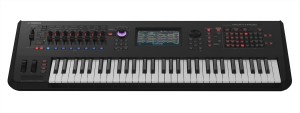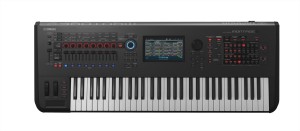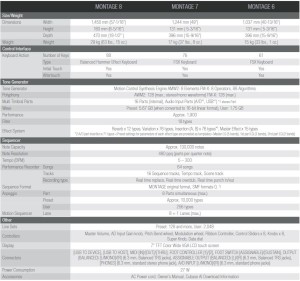Here are a few links to start your day and mine. The best new resource on the Montage is the latest issue of the Yamaha Music Production Guide.
Well, we have to get the question of money out of the way sometime:
Montage 6 $3,499.00 USD MSRP
Montage 7 $3,999.00 USD MSRP
Montage 8 $4,499.00 USD MSRP
One major on-line retailer is listing $2999.99, $3499.99 and $3999.99, respectively. The street price will probably remain high until the current Motif XF inventory clears. The Motif Fully Loaded offer is good to the end of March 2016. Yamaha is bundling the Bösendorfer Imperial Premium Grand Piano sound library as an introductory promotion to drive early adopters. Oh, Montage will ship in May 2016.
But, wait! There’s more! “Be a Montage Early Adopter and get a Free Montage Motion Control Pedal Pack!” All of the details are on this page at the US Yamaha site.
Yamaha also announced a Bösendorfer 280 VC concert grand piano (MSRP: $219,999). I don’t think Yamaha is bundling one of those with the Montage. They better fix up some of the ambiguous language on their Web pages.
Sud Claviers post some of the best demo videos around and were the first ones out of the blocks this morning.
Hope you understand French!
The demo’ed acoustic sounds are named: CFX Concert, Seattle Section, Seattle Violin, Organ AMP, B3 Curved, Folk Guitar, Electric Guitar, Modern Guitar, Choir Ensemble, Drum & Bass, Trumpet (muted), and saxophone (untitled). The synthesizer sounds are named: Side Chain, Journey Within, EP Goes, Tech FM, FM Lead, Universe, Couleur Life, 4 Pads, Soft Pads, FM Pads and Astral. A little French might have slipped in here.
There are now tons of Yamaha sponsored YouTube videos, too. One of these videos is the “Montage Development Story.” It’s about eighteen minutes long, showing the developers while they talk about their creation. There is not a lot of technical content, but the video does provide a back story on motion control and motion sequencing. The idea is to sync control to the beat. Control changes are synchronized with the Super Knob and they are synchronized with keyboard performance. The idea is to set up motion sequences that are triggered by whatever the musician plays on the keys such that the sound is transformed and evolves. The goal is to “rhythmically change tone.” Thus, it’s possible to play tones from the keyboard that would ordinarilly be created by tediously drawing the controller information into a DAW.
The Montage can sync to an external, live performance. It derives the beat from an incoming audio signal. Remember all that stuff about patents on beat detection algorithms? We’re going to see more of this from Yamaha.
The segment with the industrial design guy was a stitch. Our son started out as a graphic artist and views the world as an artist like this gentleman. The Yamaha designer spoke about the concave shape along the part of the keyboard that faces the audience. He spoke about the energy of the audience pushing against the concave shape. It reminded my of Kev. It also reminded me of why we would fight like cats and dogs about certain concepts and ideas! “You left, just as you were becoming interesting.” 🙂
Part of the retail price goes into non-recurring engineering (NRE) costs. The NRE cost needs to be recovered sometime or Yamaha would eventually go broke! There are other non-recurring costs such as set-up for manufacturing and test, and pre-launch promotion. The per-unit, recurring cost is the money spent on parts, manufacturing, quality assurance, distribution, promotion and support for a single keyboard.
I counted 50 people in the group photo of developers at the end of the video. A typical engineer’s salary in Japan is ¥ 5,500,000. The estimated annual burn rate for the Montage development group is ¥ 275,000,000 or about $2,340,000 USD, not including overhead for capital, benefits, etc. The so-called “burdened” cost of a developer is higher depending upon the overhead.
Let’s assume a $3,000 average selling price (ASP) per unit and that 10 percent of a retail sale ($300) covers NRE. Yamaha knows this number; we don’t. If development took four years, then Yamaha needs to sell:
(4 years * $2,340,000) / $300 = $9,360,000 / $300 = 31,200 units
to cover NRE. Due to the assumptions made, this is a lower bound on the break-even point! For sure, it does not include costs incurred by the international members of the team (USA, UK, etc.)
If you read my cost analysis yesterday, that was a first draft of a first draft. (Updated: January 22)
AC Hamilton and Anderton’s — who are also European retailers — posted a few hi-rez product shots. Please click on the images below for higher resolution.
And, finally, a short list of specifications. Please click the image to display in full size.
I’m sure the debate and discussion is already underway! I will update this post with further thoughts and comments.
BTW, I noticed that the Yamaha UK site is advertising the following promotion: “For a limited time only, purchase a state-of-the-art Tyros5 (61 or 76 key model) and receive a free sensational Yamaha MCR-B043D HI-FI.” Hmm, guess what’s next?




